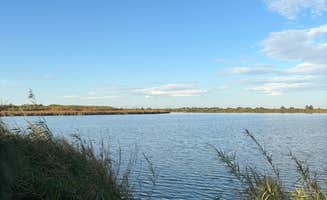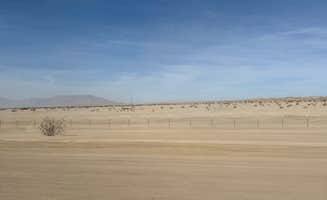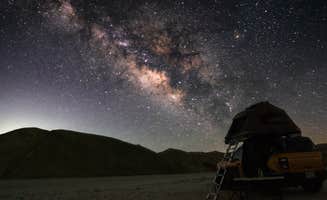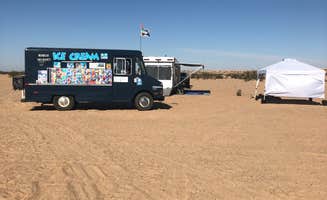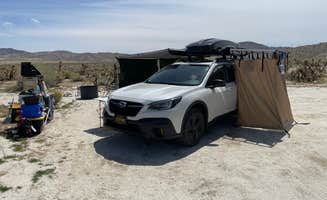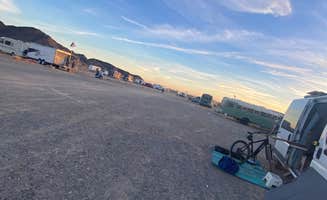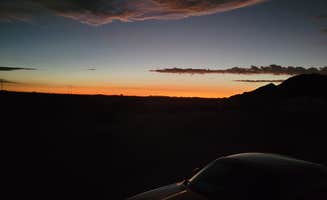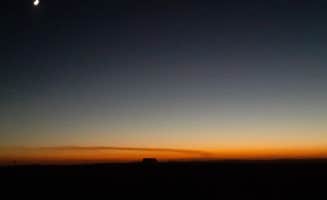Primitive camping near Imperial, California offers diverse desert landscapes with daytime temperatures reaching 110°F in summer and dropping to 40°F in winter nights. Desert dispersed sites have minimal facilities and limited shade, with most locations requiring visitors to pack in all water and supplies. Camping areas vary from flat desert terrain to box canyons and dry lakebeds.
What to do
Explore mud caves: At Arroyo Tapiado Mud Caves, visitors can discover underground passageways. "Caves are cool, dark, and spooky! No matter how hot it is in the desert the caves are always about 60F," notes Dyl A. Bring lighting equipment as the caves provide natural air conditioning during hot desert days.
Off-road adventures: The desert terrain provides extensive off-road opportunities. Octillo Wells OHV Recreation Area offers designated trails for all skill levels. Michael W. reports, "ATV rentals available. There are some picnic tables and compost hole restrooms." Many areas allow vehicles to drive directly to camping spots.
Soak in hot springs: Free natural hot springs provide welcome relief from desert conditions. Holtville Hot Springs Dispersed Site features maintained soaking pools a short walk from camping areas. Chandra B. recommends local food options: "There is great food at The Holtville Taco Shop 7 miles from springs. The Del Sol market has great marinated chicken for the BBQ."
What campers like
Night sky viewing: Desert camping areas provide exceptional stargazing opportunities with minimal light pollution. Shainna M. at Truckhaven at Ocotillo Wells State Vehicle Recreation Area states, "Open desert area, free to use. Pack it in, pack it out! Night skies are spectacular!" Clear desert air maximizes visibility of astronomical features.
Solitude and space: Many primitive sites offer privacy not found at developed campgrounds. SoCalsAngels describes Niland Marina as a "Beautiful spot near the lake with gorgeous views. Nobody as far as the eye could see, of course it's 100 degrees, but I have a trailer and awning with netting." Most dispersed areas allow campers to select sites with substantial distance between neighbors.
Wildlife observation: Desert ecosystems support unique animals and birds. Red Hill Marina Park provides access to significant bird watching opportunities. Jill F. notes, "Major plus is birding at the Salton Sea National Wildlife Refuge." Morning and evening hours offer best wildlife viewing times when desert creatures are most active.
What you should know
Weather extremes: Desert conditions create challenging camping environments requiring proper preparation. Brett S. experienced wind issues at Arroyo Tapiado: "We are novice campers - didn't have sand tent pegs so with a little wind on the day we arrived it took some time to find the right site for us. Lesson learned, take sand capable tent pegs and set up site later in the day and not on a nice hill."
Road conditions: Many primitive sites require appropriate vehicles. Kayla D. advises about Mud Caves: "There were some soft sand spots, didn't require a lot of clearance and I didn't put my Jeep Compass into AWD at all. Probably wouldn't bring a sedan, but there were SUVs pulling pop-ups."
Site cleanliness: Some areas suffer from trash issues and recreational shooting debris. Rachel S. warns about Smuggler's Gulch Dispersed: "People come out here to shoot so be warned! Theres also a lot of broken glass/rusty cans! Really pretty area though and tons of flat areas to choose from." Always inspect potential sites before setting up camp.
Tips for camping with families
Location selection: Choose campsites away from potential hazards. At Arroyo Tapiado, Kayla D. advises, "DO NOT PARK CLOSE TO THE DIRT WALLS. During the night I was out there, high winds brought down huge chunk that we had passed on the way in. There's plenty of open spaces to set up camp safely away from the walls."
Insect preparation: Desert areas can have significant insect activity depending on season. At Finney Lake Camp, Robert S. reports, "Pretty lake, but swarming with flies and a bit of an odor." Bring appropriate insect protection, particularly during warmer months.
Navigation challenges: GPS systems may provide inaccurate directions to remote camping areas. Robert S. advises about Finney Lake Camp: "GPS will try to take you onto the wrong end of Williams Road, you need to go on Titsworth -> Smith -> then Williams." Download offline maps and get specific directions before traveling to remote sites.
Tips from RVers
Site access: RV campers should research road conditions before attempting remote sites. Javier L. advises about Anza-Borrego Desert State Park: "Bring plenty of water/off road safety (enough fuel/shovel/traction boards) as towing out of this area is extremely expensive."
Self-contained capability: Most primitive sites lack water or dump facilities. Kevin F. notes about Truckhaven: "No hookups but you can stay for free on the bluffs. In some weather conditions the wind can be a bit much." Arrive with full water tanks and empty waste tanks to maximize stay duration.
Camp host resources: Some primitive areas have resident camp hosts who provide valuable local information. Chandra B. reports about Holtville Hot Springs: "It is well maintained by camp host Bill. Vault toilets, with TP." Camp hosts can advise about current conditions and any temporary restrictions.


